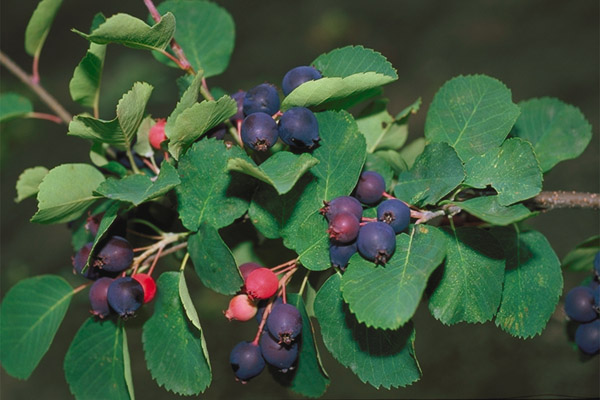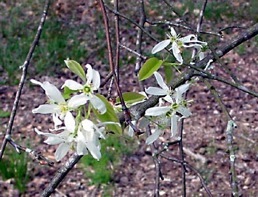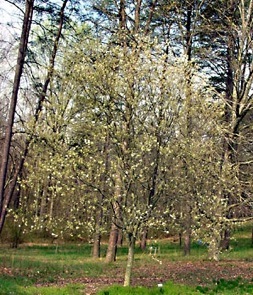Amelanchier arborea: Busting Out All Over
Juneberries are as American as apple pie. In fact, they are more American than apples.
While Juneberries are native, cultivated apples are not. When the Europeans arrived in the New World there were only sour crab apples, but plenty of sweet Juneberries, Amelanchier arborea (am-meh-LANG-kee-er ar-BORE-ee-uh.) Juneberries, however, are a close relative of the apple and have been under cultivation since 1746.
Juneberries were one of the famous traditional ingredients in pemmican, which was fat and powdered meat, or, fat, powdered meat and dried berries. Throughout the cooler areas of North America Indians made “pimekan.” It was not only a staple for the northern Indians but became the main ration for European backwoodsmen and traders. Interestingly the practice among the Indians of making pemmican did not go much farther south than Missouri or Nebraska, by Osage and the Omaha. The Missourians also mixed their Juneberries with cornmeal to make cakes, which was more in keeping with what southern tribes did. Southern Indians also made more stews and used more plants in those stews than the northern Tribes.
Opinions vary whether the Juneberry is better fresh or dried or cooked. It is a matter of personal taste. Some recipes are included below. Several species have been used for food including A. alnifolia, A. bartramiana, A. canadensis, A. intermedia, A. laevis, A. lamarckii, A. pallida, A. sanguinea, A. spicata, and A. utahensis. Species in Europe and Asia are also eaten though there is only one naturalized species of Juneberry in Europe, A. lamarckii. The Juneberry can be a multi-branched shrub or a tree to 50 feet. Like the Eastern Redbud it usually flowers in the spring before leaving out. A. arborea can be identified from the others by fuzzy emerging leaves, greenish-yellow buds, and pendulous fruit.
Amelanchier is a French corruption of the Gaulois’ word “amelanco,” thought to be their name for that plant or a similar one. Scholars guess that “amelanco” is a combination word that means little apple or downy apple. Arborea means tree-like. Besides Juneberry and Serviceberry the plant is also called Sarvis and Sarvis Tree. “Service” and “Sarvis” have the same origin in the written word “service.” Why “service?” The tree was called that be cause in Appalachia it was the only tree blossoming when it came time to bury in the thawed ground of spring those who had died during in the winter. Farther north along the coast it was called Shadbush, Shadblow, Shadwood because it
blossomed when the shad (migrating fish) were running. Other names include Saskatoon (a shortened Cree name) Sugarplum, and Wild-plum. It was called Juneberry because in many places the fruit ripens in June, usually the first of the new year for those weary of winter fare. The European species honors Jean Baptiste Antoine Monet de Lamarck, an 18th century French naturalist.
Nutritionally berries contain higher levels of protein, fat, and fiber than most other fruit but are low in vitamin C. They do have pectin, however. Lastly, the Juneberry reminds us that all berries with a “crown” on one end (like a blueberry) are edible.
Juneberry Pie
Pastry for 2 crust pie
3-4 c. juneberries, washed
2 tbsp. flour
2 tbsp. lemon juice
1/2 c. sugar
1/4 tsp. nutmeg
Sugar for sprinkling
Mix all ingredients together. Spoon into pastry lined pie plate. Top with pastry cut into strips. Sprinkle top with sugar. Bake at 450 degrees for 15 t minutes then at 350 degrees for 25 minutes more.
Juneberry Jam
4 c. Juneberries, cleaned
4 c. cut up rhubarb
4 c. white sugar
Grind Juneberries and add to sugar and rhubarb. Bring to simmer. Stir and cook until thick. Burns easily. Pour into jars. Seal. I like to add 1 teaspoon cinnamon and 1 tablespoon lemon juice to my jam.
Juneberry Muffins
2 c. flour
1/4 c. sugar
3 tsp. baking powder
1/4 tsp. salt
1/4 c. shortening
1 egg
1 c. milk
1 1/2 c. Juneberries
To dry ingredients add egg, shortening, salt and milk. When well blended stir in Juneberries. Fill muffin cups 2/3 full. Bake 20 minutes, 350 degrees.
Green Deane’s “Itemized” Plant Profile
IDENTIFICATION: A small tree or multi-stemmed large shrub, rounded crown with arching, spreading branches. Trees to 20 to 50 feet, short lived, rarely beyond 50 years, often an understory tree near stream banks. . Leaves resemble apple leaves, simple, alternate, oblong, one to three inches long, serrated, downy underneath, smoother above, silvery-gray and fuzzy when emerging, dark green in summer. Fall colors yellow to orange to red. Flowers blooms in clouds of white in early spring, five-petalled, dainty, like an apple blossom, in March and April, hang in elegant clusters. Fruit a small berry-like pome, ripens in June from green to red to purplish-black. Seeds, red teardrops. An English cultivar has red berries (A. alnifolia, var. Ballerina.)
TIME OF YEAR: Usually in June in most of its range. Most of the berries ripen at the same time and can be harvested at the same time.
ENVIRONMENT: Grows best in full sun to light shade and moist, well-drained, acid soils. More common in northern areas.
METHOD OF PREPARATION: Many. Fresh berries or dried or cooked. Can be made into pies, jelly and jams; dried it can be made into cakes or used to make pemmican. Occasionally a tree will have foul-tasting berries. Find another. There are no toxic look-alikes.





